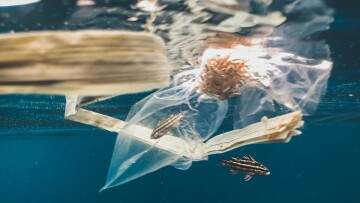
Studerandebloggen/ Student blog
The plastic in our seas

Article ”Plastic waste inputs from land into the ocean” by Jenna R. Jambeck, Roland Geyer, Chris Wilcox, Theodore R. Siegel, Miriam Perryman, Anthony Andrady, Ramani Narayan, Kara Lavender Law.
We have today a large amount of plastic in our seas, but we still don’t know the exact quantity of the plastic waste coming from our land into the ocean. A model created by eight researchers is trying to estimate the amount of plastic waste that can be found in our oceans today and it also tries to predict the amount for the year of 2025. It also identifies the biggest sources and reasons for this plastic litter in our seas and tells us how we could do better and how to reduce the amount of plastic that ends up in the water.
The commercial plastic first appeared in the 1930s and the 1940s, but people still mostly used other materials and the use of plastics wasn’t so widespread. Still in the 1960s the solid waste in the municipalities consisted of only 1% plastic while in 2005 it had gone up to at least 10% in many countries.
Why is that a problem? Because the plastic waste has a lot of negative effects on the oceans, the nature and the animals and even on us humans. It can be found everywhere today. From the deepest ocean bottoms to the surface water, in the Arctic sea as well as along all the coastlines.
The first reports about plastic litter in the sea dates to the 1970s, and now 50 years later we still don’t know exactly how much plastic waste coming from the land is drifting around in our waters.
This model (or framework as it’s also called) gives us an idea of how much of land-based plastic waste goes into the ocean every year, looking at the population living withing 50 km of a coast.
It becomes clear that the population size (how many people are living in the area) and the quality of the waste management system (refuse dumps, waste disposal, sorting and everything that has to do with waste products) affect the amount of waste that goes into the sea. And if nothing is done about it, the amount will grow more and more for each year. In the model we can see that the top 20 countries produced 83% of all the mismanaged plastic waste in 2010!
Luckily there is a solution to this problem. The countries with bad waste management need to invest money to improve the situation and minimize the amount of litter that ends up in the sea, but that of course would take time and money. In high-income countries (like Finland) with better waste management systems, we can do better starting already today, for example by stopping or reducing our use of single-use plastics, by sorting our waste better and by buying less plastic.
This article was written in the context of the "Environmental Outreach" course as part of the Sustainable Coastal Management Program at Novia UAS.
Popularizing science
Target group: school kids, 13-15 years old.
Studerandebloggen
Ansvarsfriskrivning: Författaren/författarna ansvarar för för fakta, möjlig utebliven information och innehållets korrekthet i bloggen. Texterna har genomgått en granskning, men de åsikter som uttrycks är författarens egna och återspeglar inte nödvändigtvis Yrkeshögskolan Novias ståndpunkter.
Disclaimer: The author(s) are responsible for the facts, any possible omissions, and the accuracy of the content in the blog.The texts have undergone a review, however, the opinions expressed are those of the author and do not necessarily reflect the views of Novia University of Applied Sciences.